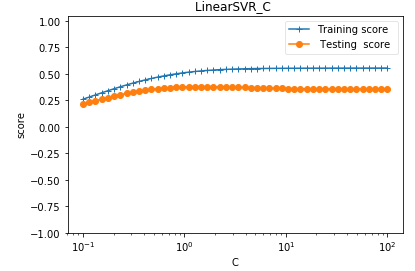吴裕雄 python 机器学习——支持向量机线性回归SVR模型
import numpy as np
import matplotlib.pyplot as plt from sklearn import datasets, linear_model,svm
from sklearn.model_selection import train_test_split def load_data_regression():
'''
加载用于回归问题的数据集
'''
diabetes = datasets.load_diabetes() #使用 scikit-learn 自带的一个糖尿病病人的数据集
# 拆分成训练集和测试集,测试集大小为原始数据集大小的 1/4
return train_test_split(diabetes.data,diabetes.target,test_size=0.25,random_state=0) #支持向量机线性回归SVR模型
def test_LinearSVR(*data):
X_train,X_test,y_train,y_test=data
regr=svm.LinearSVR()
regr.fit(X_train,y_train)
print('Coefficients:%s, intercept %s'%(regr.coef_,regr.intercept_))
print('Score: %.2f' % regr.score(X_test, y_test)) # 生成用于回归问题的数据集
X_train,X_test,y_train,y_test=load_data_regression()
# 调用 test_LinearSVR
test_LinearSVR(X_train,X_test,y_train,y_test)

def test_LinearSVR_loss(*data):
'''
测试 LinearSVR 的预测性能随不同损失函数的影响
'''
X_train,X_test,y_train,y_test=data
losses=['epsilon_insensitive','squared_epsilon_insensitive']
for loss in losses:
regr=svm.LinearSVR(loss=loss)
regr.fit(X_train,y_train)
print("loss:%s"%loss)
print('Coefficients:%s, intercept %s'%(regr.coef_,regr.intercept_))
print('Score: %.2f' % regr.score(X_test, y_test)) # 调用 test_LinearSVR_loss
test_LinearSVR_loss(X_train,X_test,y_train,y_test)

def test_LinearSVR_epsilon(*data):
'''
测试 LinearSVR 的预测性能随 epsilon 参数的影响
'''
X_train,X_test,y_train,y_test=data
epsilons=np.logspace(-2,2)
train_scores=[]
test_scores=[]
for epsilon in epsilons:
regr=svm.LinearSVR(epsilon=epsilon,loss='squared_epsilon_insensitive')
regr.fit(X_train,y_train)
train_scores.append(regr.score(X_train, y_train))
test_scores.append(regr.score(X_test, y_test))
fig=plt.figure()
ax=fig.add_subplot(1,1,1)
ax.plot(epsilons,train_scores,label="Training score ",marker='+' )
ax.plot(epsilons,test_scores,label= " Testing score ",marker='o' )
ax.set_title( "LinearSVR_epsilon ")
ax.set_xscale("log")
ax.set_xlabel(r"$\epsilon$")
ax.set_ylabel("score")
ax.set_ylim(-1,1.05)
ax.legend(loc="best",framealpha=0.5)
plt.show() # 调用 test_LinearSVR_epsilon
test_LinearSVR_epsilon(X_train,X_test,y_train,y_test)

def test_LinearSVR_C(*data):
'''
测试 LinearSVR 的预测性能随 C 参数的影响
'''
X_train,X_test,y_train,y_test=data
Cs=np.logspace(-1,2)
train_scores=[]
test_scores=[]
for C in Cs:
regr=svm.LinearSVR(epsilon=0.1,loss='squared_epsilon_insensitive',C=C)
regr.fit(X_train,y_train)
train_scores.append(regr.score(X_train, y_train))
test_scores.append(regr.score(X_test, y_test))
fig=plt.figure()
ax=fig.add_subplot(1,1,1)
ax.plot(Cs,train_scores,label="Training score ",marker='+' )
ax.plot(Cs,test_scores,label= " Testing score ",marker='o' )
ax.set_title( "LinearSVR_C ")
ax.set_xscale("log")
ax.set_xlabel(r"C")
ax.set_ylabel("score")
ax.set_ylim(-1,1.05)
ax.legend(loc="best",framealpha=0.5)
plt.show() # 调用 test_LinearSVR_C
test_LinearSVR_C(X_train,X_test,y_train,y_test)

吴裕雄 python 机器学习——支持向量机线性回归SVR模型的更多相关文章
- 吴裕雄 python 机器学习——支持向量机非线性回归SVR模型
import numpy as np import matplotlib.pyplot as plt from sklearn import datasets, linear_model,svm fr ...
- 吴裕雄 python 机器学习——支持向量机SVM非线性分类SVC模型
import numpy as np import matplotlib.pyplot as plt from sklearn import datasets, linear_model,svm fr ...
- 吴裕雄 python 机器学习——支持向量机线性分类LinearSVC模型
import numpy as np import matplotlib.pyplot as plt from sklearn import datasets, linear_model,svm fr ...
- 吴裕雄 python 机器学习——层次聚类AgglomerativeClustering模型
import numpy as np import matplotlib.pyplot as plt from sklearn import cluster from sklearn.metrics ...
- 吴裕雄 python 机器学习——密度聚类DBSCAN模型
import numpy as np import matplotlib.pyplot as plt from sklearn import cluster from sklearn.metrics ...
- 吴裕雄 python 机器学习——KNN回归KNeighborsRegressor模型
import numpy as np import matplotlib.pyplot as plt from sklearn import neighbors, datasets from skle ...
- 吴裕雄 python 机器学习——KNN分类KNeighborsClassifier模型
import numpy as np import matplotlib.pyplot as plt from sklearn import neighbors, datasets from skle ...
- 吴裕雄 python 机器学习——半监督学习LabelSpreading模型
import numpy as np import matplotlib.pyplot as plt from sklearn import metrics from sklearn import d ...
- 吴裕雄 python 机器学习——线性回归模型
import numpy as np from sklearn import datasets,linear_model from sklearn.model_selection import tra ...
随机推荐
- 斜率优化 DP
CF311B Cats Transport 暑假到现在终于过了这道题
- JQuery函数 $.ajax()
ajax() 方法通过 HTTP 请求加载远程数据 该方法是 jQuery 底层 AJAX 实现.简单易用的高层实现见 $.get, $.post 等.$.ajax() 返回其创建的 XMLHttpR ...
- Selenium3+python自动化009- js之屏幕滑动和日历操作
一.js的滑屏 1)以下脚本实现js滑屏scroll="document.documentElement.scrollTop=800"#垂直滚动 pxscroll = " ...
- npm 模块开发调试技巧之最优方案npm link
在我们平时写项目中,当我们需要新开发或修改的 npm 模块时,如何在本地项目中调试呢? 本地项目路径:G:\npm\project 开发的模块路径:G:\npm\model 方法一: 在cmd命令窗口 ...
- SpringBoot学习- 2、使用IDEA创建项目
SpringBoot学习足迹 上一节使用sts创建项目,感觉只是基于eclipse做了一些界面定制,还是改使用IDEA开发,为了跟上时代,将使用IDEA最新版本,安装各种最新插件. 1.下载IDEA ...
- 如来十三掌-关于不断解密的密码学,佛语解密,rot-13(根据13掌),base64
得到MzkuM3gvMUAwnzuvn3cgozMlMTuvqzAenJchMUAeqzWenzEmLJW9 然后尝试嘛 base64不太行 那根据十三掌??rot-13 得到ZmxhZ3tiZHNj ...
- 打表法fffff
打表法: 打表前先运行一下 看一看速度 优化: O3 #pragma GCC optimize(3,"Ofast","inline") O2 #pragma ...
- java课后作业2
动手动脑 编写一个方法,使用以上算法生成指定数目(比如1000个)的随机整数 import java.util.Random;import java.util.Scanner;public class ...
- not under version control
表示这个文件没有在SVN的控制之下 你在执行commit操作的时候,只有处于SVN控制之下的文件才能被commit,从update得到的文件是在SVN控制之下的(比如原来就存在的文本文件,你可以对其修 ...
- redis缓存处理机制
1.redis缓存处理机制:先从缓存里面取,取不到去数据库里面取,然后丢入缓存中 例如:系统参数处理工具类 package com.ztesoft.iotcmp.utils; import com.e ...
